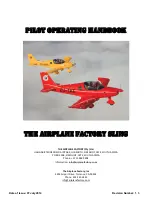
INCIDENTS IN FLIGHT
EN
17
16
Active C Riser Control
When gliding it is possible to pilot the wing with the C risers, this gives an improved feel and control over
the wing enabling you to fly actively without using the brakes. Using brakes whilst accelerated causes
drag which is not only inefficient but it also reduces the inherent stability of the profile - using the brakes
whilst accelerated can actually lead to a collapse. Using the C risers increases the angle of attack evenly
across the chord and does not weaken the profile, the direct feel allows you to stop collapses before they
happen whilst maintaining a higher speed and higher level of efficiency through turbulence.
To fly with the C risers, keep hold of your brake handles (remove any wraps) and take hold of the C risers.
If you see or feel the leading edge lose pressure, you can input to the C risers to help keep the nose open.
Be careful to use only small inputs with the C risers, you risk stalling part or all of the wing if you are over
enthusiastic. The amount of pressure and size of the input is dependent on the amount of turbulence/loss
of pressure, but always be gentle at first.
Be prepared for plenty of practice as this new method may take some time for it to become totally intuitive,
efficient and comfortable. This control method is suitable for gliding in good ‘normal’ air, it does not
replace proper active flying on the brakes in strong turbulent conditions. If you are unsure about the air
release the C risers, return the glider to the white line trimmer position and fly actively with the brakes.
Accelerator
The SwiftMAX risers feature pulleys on the A risers for the installation of a foot operated accelerator
system. The wing was certified with the trimmers only, the speed system is an uncertified alternative
method of acceleration, the installation and use therefore is entirely at the pilot’s discretion.
To use the accelerator you must first mount the speed system lines correctly. Attach the supplied speed
system line to the loop of the upper pulley, then route it through the pulleys as shown in the riser diagram
before attaching the brummel hook.
The speed system has a range of 8cm and can be used instead of the trimmers, it is strongly recommended
to not use the accelerator with the trimmers released. Always return the trimmers to the slow position
before operating the accelerator.
Deflations
Due to the flexible form of a paraglider, turbulence may cause a portion of the wing suddenly to collapse.
This can be anything from a small 30% (asymmetric) collapse to a complete (symmetric) collapse.
If you have a collapse, the first thing to do is to control your direction. You should fly away from the ground
or obstacles and other pilots. Asymmetric collapses should be controlled by weight shifting away from the
collapse and applying enough brake to control your direction. This action alone will be enough for a full
recovery of the wing most of the time.
Once a glider is deflated it is effectively a smaller wing, so the wing loading and stall speed are higher. This
means the glider will spin or stall with less brake input than normal. In your efforts to stop the glider turning
towards the collapsed side of the wing you must be very careful not to stall the side of the wing that is still
flying. If you are unable to stop the glider turning without exceeding the stall point then allow the glider to
turn whilst you reinflate the collapse.
If you have a deflation which does not spontaneously reinflate, make a long smooth progressive pump
on the deflated side. This pumping action should take about 1-2 seconds per pump. Pumping too short
and fast will not reinflate the wing and pumping too slow might take the glider close to, or beyond, the
stall point.
Symmetrical collapses reinflate without pilot input, however 15 to 20cm of brake applied symmetrically will
speed the process. After a symmetric collapse always consider your airspeed. Make sure the glider is not
in parachutal stall before making any further inputs.
If the wing collapses in accelerated flight, immediately release the accelerator (if applied), manage the
collapse using the same methods described above and then return the trimmers to the white line position.
IMPORTANT
The accelerator is
uncertified. Do not use
the accelerator with
the trimmers released
Содержание SwiftMax
Страница 1: ...Pilots Manual ...
Страница 2: ......
Страница 19: ...1258 Route de Grasse Le Bar sur Loup 06620 France ...































